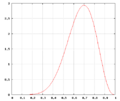Checking whether a coin is fair
Checking whether a coin is fair involves determining if a coin has an equal chance of landing on heads or tails when flipped. This concept is crucial in the field of probability theory and statistics, as it touches upon the fundamental principles of randomness and fairness in experiments and statistical inference.
Definition
A coin is considered fair if the probability of landing on heads (P(H)) is equal to the probability of landing on tails (P(T)), with both probabilities being 0.5. In contrast, a coin that does not meet this criterion is deemed biased or unfair.
Methods of Checking Coin Fairness
Several methods can be employed to assess the fairness of a coin, ranging from simple experiments to complex statistical tests.
Flip Experiment
The most straightforward method is to flip the coin a large number of times and record the outcomes. If the number of heads and tails are approximately equal, the coin can be considered fair. However, due to the Law of Large Numbers, the experiment should include a sufficiently large number of flips to reach a reliable conclusion.
Chi-Squared Test
The Chi-squared test is a more sophisticated statistical method used to determine if the observed outcomes significantly deviate from the expected outcomes. In the context of a coin flip, if the observed frequencies of heads and tails significantly differ from what is expected in a fair coin, the coin may be considered biased.
Bayesian Inference
Bayesian inference offers another approach to evaluating coin fairness. This method involves updating the probability of the coin being fair based on prior beliefs and the outcomes of coin flips. It provides a probabilistic framework to assess fairness, taking into account prior knowledge and new evidence.
Applications
Understanding and determining coin fairness has applications in various fields, including gambling, where ensuring the fairness of games is crucial, and in randomized controlled trials in medicine, where randomization processes must be unbiased to ensure the validity of the results.
Challenges
One of the main challenges in checking coin fairness is determining the number of flips necessary to make a reliable assessment. Additionally, physical imperfections in the coin or biases in the flipping method can influence the outcomes, complicating the assessment of fairness.
Conclusion
Checking whether a coin is fair is a fundamental problem in probability and statistics, with significant implications for research and practical applications. While simple experiments can provide initial insights, statistical tests offer more definitive assessments of a coin's fairness.
This article is a statistics-related stub. You can help WikiMD by expanding it!
Checking whether a coin is fair
Transform your life with W8MD's budget GLP-1 injections from $125.
W8MD offers a medical weight loss program to lose weight in Philadelphia. Our physician-supervised medical weight loss provides:
- Most insurances accepted or discounted self-pay rates. We will obtain insurance prior authorizations if needed.
- Generic GLP1 weight loss injections from $125 for the starting dose.
- Also offer prescription weight loss medications including Phentermine, Qsymia, Diethylpropion, Contrave etc.
NYC weight loss doctor appointments
Start your NYC weight loss journey today at our NYC medical weight loss and Philadelphia medical weight loss clinics.
- Call 718-946-5500 to lose weight in NYC or for medical weight loss in Philadelphia 215-676-2334.
- Tags:NYC medical weight loss, Philadelphia lose weight Zepbound NYC, Budget GLP1 weight loss injections, Wegovy Philadelphia, Wegovy NYC, Philadelphia medical weight loss, Brookly weight loss and Wegovy NYC
|
WikiMD's Wellness Encyclopedia |
| Let Food Be Thy Medicine Medicine Thy Food - Hippocrates |
Medical Disclaimer: WikiMD is not a substitute for professional medical advice. The information on WikiMD is provided as an information resource only, may be incorrect, outdated or misleading, and is not to be used or relied on for any diagnostic or treatment purposes. Please consult your health care provider before making any healthcare decisions or for guidance about a specific medical condition. WikiMD expressly disclaims responsibility, and shall have no liability, for any damages, loss, injury, or liability whatsoever suffered as a result of your reliance on the information contained in this site. By visiting this site you agree to the foregoing terms and conditions, which may from time to time be changed or supplemented by WikiMD. If you do not agree to the foregoing terms and conditions, you should not enter or use this site. See full disclaimer.
Credits:Most images are courtesy of Wikimedia commons, and templates, categories Wikipedia, licensed under CC BY SA or similar.
Contributors: Prab R. Tumpati, MD

